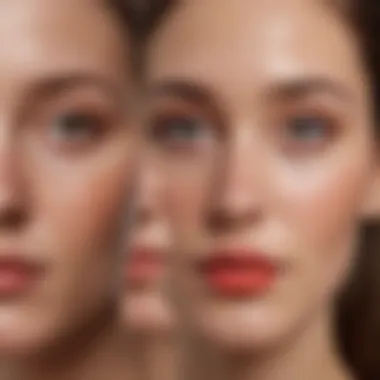Exploring Red Light Therapy for Acne Treatment


Intro
Acne is a common skin condition that affects women of various ages. The pursuit of effective treatments has led to a multitude of options, with red light therapy emerging as a notable alternative. This article examines the scientific grounding of red light therapy and its proposed effectiveness in treating acne. Additionally, it reviews the potential benefits, application methods, and the broader context of skincare integration. By exploring the available research, we aim to offer a well-informed view for those considering this therapy as part of their beauty regimen.
As we delve deeper into this subject, readers will find actionable insights to address their questions and concerns about employing red light therapy against acne. Understanding this therapeutic approach can help illuminate the path toward clearer skin.
Intro to Red Light Therapy
Red light therapy has gained attention in recent years as a promising option for treating acne. This non-invasive treatment uses specific wavelengths of light to target skin issues, with potentially significant effects. Understanding the role of red light therapy in acne treatment is important for those looking for alternatives beyond conventional methods. Knowing about its benefits and applications can empower individuals to make informed choices for their skin health.
Understanding Red Light Therapy
Red light therapy involves the application of red light wavelengths, typically ranging from 600 to 660 nanometers. The treatment works by penetrating the skin to stimulate cellular processes. Key benefits include increased energy production in cells, enhanced blood flow, and improved healing processes. This therapy is thought to influence skin health positively, particularly by promoting collagen production and reducing inflammation.
Many use red light therapy for multiple skin concerns, and acne is a primary focus. It helps in decreasing the appearance of acne lesions and contributing to overall skin rejuvenation. Users often appreciate the absence of harsh chemicals and invasive procedures.
History of Light Therapy in Medicine
The concept of using light for medical purposes is not new. Historical records indicate that light therapy has been around for centuries, with applications in treating various ailments. The use of light to heal dates back to ancient Egyptians who used sunlight as a healing method. In the 20th century, scientists began to explore the therapeutic applications of light in more detail.
Initially, blue light was recognized for its antibacterial properties. Researchers discovered that certain light wavelengths could kill acne-causing bacteria effectively. Later studies expanded these findings, showing the advantages of red light as well, particularly regarding its anti-inflammatory and healing effects. This progression led to a broader acceptance of light therapy in dermatology, opening the door to potential benefits it holds for acne treatment.
In summary, the emerging evidence surrounding red light therapy presents a compelling case. As interest grows, additional research continues to enhance our understanding of its role in acne management and skincare.
Mechanisms of Action
Understanding the mechanisms of action behind red light therapy is essential for grasping its effectiveness in acne treatment. This section will discuss how red light therapy interacts with skin cells and the underlying processes that contribute to its benefits in managing acne. By exploring these mechanisms, we can appreciate its role and relevance in skincare routines.
Cellular Response to Red Light
ATP Production
A key aspect of ATP production in the context of red light therapy is its role in cellular energy generation. Adenosine triphosphate serves as the primary energy carrier in living organisms. Red light, typically in the range of 600 to 660 nanometers, can penetrate the skin layers and stimulate the mitochondria, which are the powerhouses of cells. This stimulation increases the production of ATP. A higher ATP level means cells can perform their functions more effectively. This enhanced performance is crucial in the context of acne management because it supports overall skin health.
The significant characteristic of ATP production is its direct link to energy metabolism and cellular repair processes. Increased energy allows skin cells to regenerate more efficiently. This is a beneficial attribute for those suffering from acne, as it promotes faster healing and improves the skin barrier.
Unique feature: Enhanced ATP production can be advantageous for quicker responses in damaged skin. However, it is essential to consider that increased cellular activity might not always translate into uniform results for every individual. Different skin types may respond variably.
Collagen Synthesis
Collagen synthesis is another vital point when discussing red light therapy. Collagen is the main structural protein in the skin, providing firmness and elasticity. Red light therapy has been shown to stimulate fibroblast activity, which plays a crucial role in collagen production. The increased collagen production may help in reducing acne scars and improving overall skin texture.
A notable characteristic of collagen synthesis is its long-term benefits in skin rejuvenation. This effect contributes to a more youthful appearance, making it a popular choice in the beauty community. Many users appreciate its dual action: treating active acne and targeting age-related skin issues simultaneously.
Unique feature: The potential for collagen production to reduce scarring is a significant advantage. However, the process can take time, and results may not be immediate, necessitating consistent use of red light therapy.
Anti-Inflammatory Effects
The anti-inflammatory effects of red light therapy are crucial for acne treatment. Acne often involves an inflammatory response, which contributes to the severity and persistence of the condition. By targeting inflammation, red light therapy can help reduce redness and swelling associated with acne lesions.
The key characteristic of this aspect is its ability to lower pro-inflammatory cytokines. This reduction helps calm the skin and promotes a healthier complexion. For individuals who struggle with inflammatory acne, this benefit is particularly valuable.


Unique feature: The capability to decrease inflammation can lead to improved visual outcomes of acne lesions. Nonetheless, it is important to note that while red light therapy can significantly help in reducing inflammation, it should be seen as a part of a broader treatment approach.
Impact on Skin Conditions
Acne Bacterial Reduction
Acne is often aggravated by the presence of P. acnes bacteria. Red light therapy can assist in reducing the population of these bacteria on the skin surface. By utilizing specific wavelengths, it disrupts the bacterial cells, which in turn, minimizes the incidence of breakouts.
The key characteristic here is its effect on bacterial load without the need for harsh chemicals. This makes red light therapy a more gentle approach to acne treatment, appealing to those who prefer non-invasive options.
Unique feature: The effectiveness in targeting acne-causing bacteria presents a unique advantage in prevention. However, results can vary based on individual skin conditions, and ongoing usage may be necessary to maintain low bacterial levels.
Sebum Regulation
Sebum regulation is critical in acne management. Excess oil production can clog pores and create the perfect environment for acne development. Red light has been shown to assist in normalizing sebum production over time, helping to maintain clearer skin.
The significant characteristic of this effect lies in its long-term skin health benefits. By regulating oil production, individuals can potentially experience fewer breakouts. Many users highlight the positive correlation between consistent therapy and improved skin clarity.
Unique feature: The potential for sebum regulation offers a proactive strategy in managing acne. However, it is essential to note that individual results may differ, and combining red light therapy with other preventive measures could yield better outcomes.
Skin Repair Processes
Skin repair processes are critical in managing acne, especially post-breakout. Red light therapy aids in accelerating these processes, allowing skin to heal quicker after blemishes and lesions. This is particularly important as it enhances recovery and minimizes the chances for scarring.
The key characteristic of these repair processes is the promotion of faster cell turnover. Enhanced cellular regeneration not only helps in clearing active acne but also in improving the overall texture of the skin. This benefit can help many users regain confidence in their appearance over time.
Unique feature: Accelerated skin repair represents a beneficial method to address both current acne and its aftermath. Nevertheless, consistent application and patience are key, as results may take some time to manifest.
The Connection Between Acne and Inflammation
Understanding the link between acne and inflammation is crucial. This connection sheds light on why some individuals experience breakouts more than others. The inflammatory process is a significant factor in acne development, affecting both severity and treatment outcomes. By grasping this relationship, we can better appreciate how therapies, including red light therapy, can play a role in managing acne.
Understanding Acne Development
Acne develops when hair follicles become clogged with oil and dead skin cells. Several factors contribute to this clogging, including hormonal levels, genetics, and certain lifestyle factors. When hair follicles are blocked, the environment becomes favorable for the growth of bacteria, particularly Propionibacterium acnes. This bacterium is naturally found on the skin, but when it proliferates, it contributes to inflammation.
As the body attempts to fight off the bacteria, an inflammatory response is triggered. This causes redness, swelling, and tenderness in the affected areas. Knowledge of these mechanisms helps explain why some treatments that target inflammation can effectively reduce acne severity.
Inflammation's Role in Acne
Inflammation has a direct connection to acne progression. It does not merely contribute to the visible signs of acne; it also influences future breakouts. The chronic nature of inflammation can lead to lasting skin damage, including scarring and post-inflammatory hyperpigmentation.
The body responds to acne lesions as if they were infections, leading to an influx of immune cells to the area. While this is a natural response, excessive or prolonged inflammation can worsen the skin condition. The link between inflammation and acne highlights the potential benefits of treatments that mitigate the inflammatory process. Red light therapy is one such option, as it offers anti-inflammatory properties, helping to calm the skin and potentially reduce lesion formation.
"Understanding the inflammatory mechanisms behind acne can lead to better treatment strategies, promoting a more comprehensive approach to skincare."
In summary, examining the connection between acne and inflammation is vital for a well-rounded understanding of acne management. It emphasizes the need for treatments that address both the external manifestations of acne and its underlying inflammatory processes.
Research on Red Light Therapy and Acne
The relevance of research in the sphere of red light therapy for acne treatment is multifaceted. Understanding the clinical outcomes and scientific principles is essential for both practitioners and patients. The existing literature aids in comprehending how red light therapy can be integrated into skincare routines and its efficacy against acne. With a growing interest in non-invasive treatment options, solid research helps in legitimizing red light therapy as a viable alternative for managing this common skin condition.
Through rigorous clinical studies, the benefits and limitations of this approach can be systematically examined. Insights drawn from these studies can guide the development of treatment protocols and inform consumers about expected results. The advancements in technology and treatment methodologies also call for ongoing research to assess new devices and their impact on various skin types.


Clinical Studies Review
Clinical studies focusing on red light therapy and its impact on acne have produced a body of evidence illustrating effectiveness. For instance, a myriad of studies have shown that patients experience a reduction in acne lesions after a series of red light therapy sessions. These investigations often utilize different wavelengths and parameters, comparing them to other acne treatments, to elucidate the most effective methods.
Numerous systematic reviews summarize findings from these clinical trials, providing clearer insights into the therapy's efficacy. Some studies suggest that red light therapy can significantly reduce inflammation, one of the main causes of acne. Many trials point to the added benefits of combined therapies where red light is used alongside topical treatments, leading to a more holistic approach to managing acne.
The consistency of favorable outcomes across various demographics also indicates that multiple skin types can benefit from this treatment. However, variability in individual responses highlights the importance of tailored treatment plans. This underlines the potential for ongoing research to determine more personalized approaches.
Comparative Effectiveness
Comparative effectiveness research explores how red light therapy stacks up against traditional acne treatments, such as oral medications and topical solutions. While antibiotics and retinoids have been long established, they may not be suitable for everyone due to side effects or resistance concerns.
Red light therapy presents itself as a compelling alternative, showing both safety and efficacy. Studies typically compare treatment regimens based on clarity of results, patient satisfaction, and side effects experience. Many findings indicate that red light therapy can provide relief without the adverse reactions associated with pharmaceutical options.
One particular study published in a dermatological journal noted that patients receiving red light therapy reported fewer instances of irritation compared to those using traditional treatments. Notably, the non-invasive nature of red light therapy appeals to those hesitant about harsher treatments.
Practical Application of Red Light Therapy
Understanding the practical application of red light therapy is essential for effectively managing acne. This treatment method not only offers specific benefits in acne reduction but also serves as part of a broader skin health strategy. Women seeking clearer skin may find red light therapy a valuable addition to their beauty routines. It allows for an at-home treatment option and can complement other skincare practices.
Devices Available for Home Use
LED Masks
LED masks are popular among users for their convenience and ease of use. A key characteristic of these devices is their full-face coverage, enabling uniform exposure to red light. This feature makes LED masks a beneficial choice for individuals looking to target various areas of the face simultaneously. The unique advantage of LED masks lies in their ability to incorporate multiple wavelengths of light, offering both red and near-infrared therapy. While many users report positive results, it is important to follow manufacturer guidelines to avoid overuse, which can lead to redness or irritation.
Handheld Devices
Handheld devices provide a focused application of red light therapy, making them an adaptable option for users. Their portability stands out as a significant characteristic, allowing individuals to apply the treatment to specific areas of concern, such as active blemishes. This flexibility is beneficial, as it permits tailored treatment sessions. However, users might find the need for more frequent treatments per session compared to full-face devices, which could impact convenience for some individuals. They tend to be suitable for short but targeted sessions, ensuring that individuals can concentrate on particular issues like inflamed spots.
Panels
Light therapy panels are sizable devices that cover a large area at once, typically used for broader treatment goals. The key characteristic here is their ability to deliver consistent light exposure over a larger portion of the body, which can be useful in cases of extensive acne. This design offers the advantage of quicker sessions, as larger areas can be treated simultaneously. However, they require more space than handheld devices or masks, which may not be ideal for every home setup. Users should consider their available space when evaluating whether a panel is a practical option for them.
Usage Guidelines
Duration and Frequency
Proper guidance on duration and frequency of use is crucial for maximizing benefits. Treatment duration typically ranges from 10 to 20 minutes, with recommendations suggesting two to three sessions per week for optimal results. This characteristic ensures that individuals are not overwhelming their skin, which is a common concern with light therapies. Moreover, consistent exposure allows the skin to gradually benefit from the therapy while minimizing the risk of adverse reactions. Users must be consistent in their regimen to see long-term improvements in acne.
Complementary Skincare Products
Integrating complementary skincare products with red light therapy can enhance its effectiveness. Products that support skin health, such as gentle cleansers and non-comedogenic moisturizers, play a vital role. A key feature is that these products can help prepare the skin for light therapy, ensuring that the skin barrier is healthy and receptive. While some may think that all products are suitable for use alongside the therapy, it's essential to choose ones that will not cause irritation. This leads to a more favorable outcome when combining treatments.
Potential Side Effects
Awareness of potential side effects from red light therapy is imperative. Although it is generally well-tolerated, some users experience mild sensations like warmth or slight redness after treatment. A key characteristic of understanding these effects is that they help users set realistic expectations. While serious side effects are rare, users should always perform a patch test before full application, ensuring their skin reacts positively. Having a clear understanding of these aspects can mitigate concerns and ensure that users feel comfortable with their chosen treatment.
Benefits of Red Light Therapy Beyond Acne
Red light therapy offers several potential benefits that extend beyond its applications in acne treatment. Understanding these advantages is crucial for women seeking comprehensive skincare solutions. This section explores the notable properties of red light therapy, particularly focusing on wound healing and anti-aging effects. These elements provide an attractive option for individuals looking to enhance their overall skin health and appearance.
Wound Healing Properties


Red light therapy has been researched for its wound healing capabilities. The use of low-level lasers or LED lights can stimulate cellular processes that contribute to tissue repair. This natural healing effect is particularly valuable for women who may be prone to minor cuts, scratches, or skin irritations.
When red light penetrates the skin, it enhances cellular activity. Cells receive a boost in energy production, primarily through increased ATP levels. This is essential because ATP fuels cellular functions necessary for repair and regeneration. In addition, red light therapy promotes collagen production. Collagen is a protein that boosts skin elasticity, helping it to recover from wounds more effectively.
"Red light therapy can significantly accelerate the healing process of both acute and chronic wounds, making it a suitable option for skincare routines seeking holistic benefits."
Some studies indicate that red light therapy can decrease inflammation as well. By addressing inflammation, the therapy alleviates discomfort and further supports the body's natural healing processes. For women, these attributes translate into smoother skin and fewer visible scars after injury.
Anti-Aging Effects
The anti-aging properties of red light therapy garner significant attention. Many women seek effective methods to reduce visible signs of aging, such as fine lines, wrinkles, and uneven skin tone. Red light therapy offers a non-invasive approach with its potential to rejuvenate the skin.
One way red light therapy combats aging is through its influence on collagen synthesis. As natural collagen levels decline with age, skin can lose its firmness and elasticity. Regular treatments can stimulate collagen production, providing a more youthful appearance over time.
Additionally, red light therapy can enhance blood circulation. Increased blood flow not only delivers essential oxygen and nutrients to skin cells but also aids in the removal of toxins. This dual action helps improve skin texture and luminosity.
Furthermore, this therapy can diminish pigmentation issues and promote an even skin tone. By supporting skin cell turnover, it helps to mitigate the appearance of age spots, giving the skin a fresher look.
The growing interest in red light therapy encourages further examination of its benefits, ensuring that women are informed and can make choices aligned with their skincare goals.
Considerations and Contraindications
When exploring red light therapy for acne treatment, it is essential to understand the considerations and contraindications involved. This knowledge ensures safe usage and helps in maximizing the benefits of the therapy. The therapy is generally considered safe, but it is not suitable for everyone. Understanding one’s skin type and sensitivity helps tailor the treatment to individual needs. Furthermore, professional guidance is crucial for a successful skincare strategy.
Skin Types and Sensitivities
Different skin types react uniquely to red light therapy. For example:
- Oily Skin: Those with oily skin may experience different results compared to individuals with dry skin. The therapy can regulate sebum production, but proper techniques are necessary to balance oiliness without over-drying.
- Dry Skin: Individuals with dry or sensitive skin should proceed cautiously. Red light therapy can help rejuvenate skin, but the heat generated might exacerbate sensitivity. Starting with shorter sessions can minimize adverse reactions.
- Combination Skin: Managing different areas may pose a challenge. Users with this skin type should keep a close eye on their response and adjust their approach as necessary. Segmentation of treatment might be beneficial.
- Acne-Prone Skin: This type can particularly benefit from red light therapy, but it is vital to assess the severity of acne. Those with severe cystic acne may find it beneficial but should also consider accompanying methods like targeted medications.
Having knowledge of individual skin properties enhances the effectiveness of red light therapy. It compresses time spent on trial and error, providing quicker results while reducing irritation risk.
Consultation with Professionals
Before embarking on any new treatment, especially one like red light therapy, consulting with dermatology professionals is critical. Their expertise provides insights into whether this therapy is suitable based on skin conditions and sensitivities. Here are some key reasons for seeking professional guidance:
- Medical History: Professionals analyze personal medical histories, checking for conditions that may contraindicate the use of light therapy, such as certain skin diseases or conditions like lupus.
- Skin Assessment: A professional can accurately assess skin type and understanding the condition’s severity. This assessment assures personalized treatment, which is pivotal for optimal results.
- Customized Treatment Plans: With their experience, professionals can develop a tailored approach. This may include the ideal type of device, treatment frequency, and additional complementary therapies to combine with red light.
- Monitoring Progress: Regular consultations enable ongoing evaluation of the skin's response to treatment. Adjustments can then be made accordingly, ensuring the approach remains effective and safe over time.
The relationship between patients and their dermatologists cannot be overstated. It is this partnership that ultimately leads to effective skincare strategies and better outcomes.
Taking these considerations into account significantly contributes to a successful acne treatment experience with red light therapy. The right approach ensures that the therapy integrates smoothly into a larger skincare routine.
The End
In the realm of skincare, understanding the potential of red light therapy is crucial, especially for those struggling with acne. This article has offered a thorough examination of red light therapy, elucidating its mechanisms and benefits, as well as considerations for safe integration into daily routines. The significance of addressing acne through this innovative treatment option cannot be understated.
Summary of Findings
Red light therapy operates primarily by enhancing cellular function, which is central to acne management. Research indicates it aids in reducing inflammation, promoting healing, and diminishing bacterial activity on the skin. Key findings from clinical studies reveal:
- Efficacy in reducing acne lesions: Many users report a notable decrease in breakouts after consistent application.
- Improved skin appearance: Users often experience a more luminous complexion, attributed to enhanced collagen production and skin repair.
- Edge over traditional methods: Compared to topical treatments, red light therapy may offer a gentler alternative with fewer side effects.
These findings substantiate the role of red light therapy as a helpful adjunct in the fight against acne, enhancing both skin health and overall appearance.
Future Research Directions
While the current research on red light therapy is promising, further investigation remains essential to fully comprehend its effects and optimize its use for acne treatment. Future studies might consider:
- Long-term effects: Investigation into the sustained benefits and any potential side effects over extended periods of use.
- Comparative studies with other treatments: Evaluating the effectiveness of red light therapy against established acne treatments, such as oral medications or chemical peels.
- Diverse skin types: Exploring the variations in response to therapy across different skin types and conditions, allowing for personalized treatment plans.







